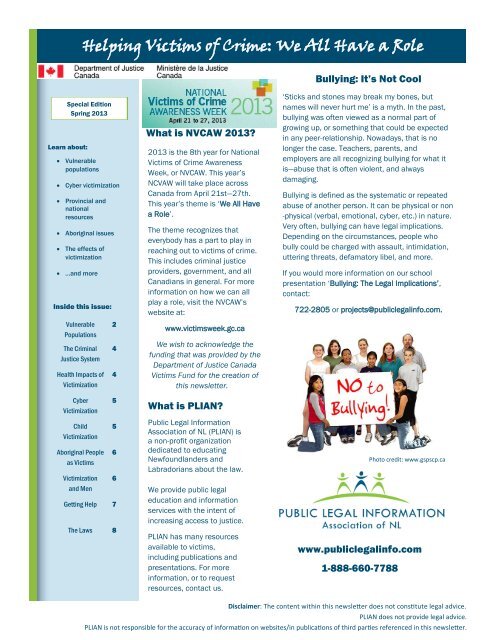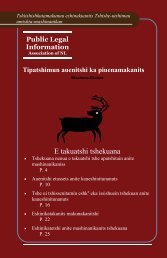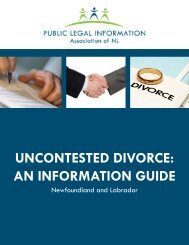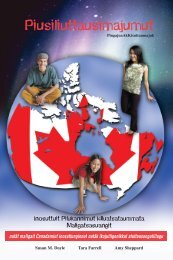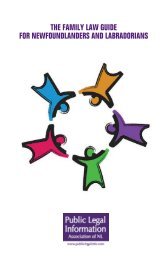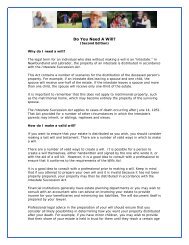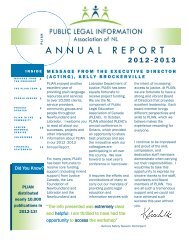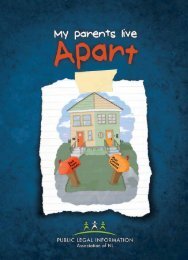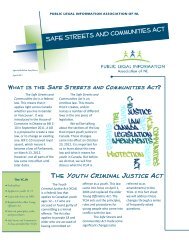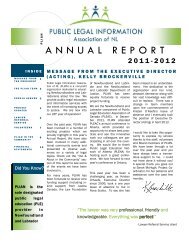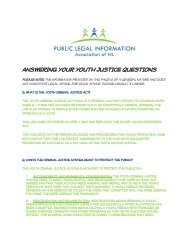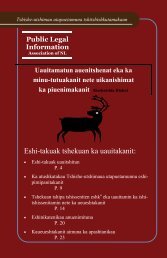here - Public Legal Information
here - Public Legal Information
here - Public Legal Information
Create successful ePaper yourself
Turn your PDF publications into a flip-book with our unique Google optimized e-Paper software.
Helping Victims of Crime: We All Have a Role<br />
Bullying: It’s Not Cool<br />
Special Edition<br />
Spring 2013<br />
Learn about:<br />
Vulnerable<br />
populations<br />
Cyber victimization<br />
Provincial and<br />
national<br />
resources<br />
Aboriginal issues<br />
The effects of<br />
victimization<br />
...and more<br />
Inside this issue:<br />
Vulnerable<br />
Populations<br />
The Criminal<br />
Justice System<br />
Health Impacts of<br />
Victimization<br />
Cyber<br />
Victimization<br />
Child<br />
Victimization<br />
Aboriginal People<br />
as Victims<br />
Victimization<br />
and Men<br />
2<br />
4<br />
4<br />
5<br />
5<br />
6<br />
6<br />
Getting Help 7<br />
The Laws 8<br />
What is NVCAW 2013?<br />
2013 is the 8th year for National<br />
Victims of Crime Awareness<br />
Week, or NVCAW. This year’s<br />
NCVAW will take place across<br />
Canada from April 21st—27th.<br />
This year’s theme is ‘We All Have<br />
a Role’.<br />
The theme recognizes that<br />
everybody has a part to play in<br />
reaching out to victims of crime.<br />
This includes criminal justice<br />
providers, government, and all<br />
Canadians in general. For more<br />
information on how we can all<br />
play a role, visit the NVCAW’s<br />
website at:<br />
www.victimsweek.gc.ca<br />
We wish to acknowledge the<br />
funding that was provided by the<br />
Department of Justice Canada<br />
Victims Fund for the creation of<br />
this newsletter.<br />
What is PLIAN?<br />
<strong>Public</strong> <strong>Legal</strong> <strong>Information</strong><br />
Association of NL (PLIAN) is<br />
a non-profit organization<br />
dedicated to educating<br />
Newfoundlanders and<br />
Labradorians about the law.<br />
We provide public legal<br />
education and information<br />
services with the intent of<br />
increasing access to justice.<br />
PLIAN has many resources<br />
available to victims,<br />
including publications and<br />
presentations. For more<br />
information, or to request<br />
resources, contact us.<br />
‘Sticks and stones may break my bones, but<br />
names will never hurt me’ is a myth. In the past,<br />
bullying was often viewed as a normal part of<br />
growing up, or something that could be expected<br />
in any peer-relationship. Nowadays, that is no<br />
longer the case. Teachers, parents, and<br />
employers are all recognizing bullying for what it<br />
is—abuse that is often violent, and always<br />
damaging.<br />
Bullying is defined as the systematic or repeated<br />
abuse of another person. It can be physical or non<br />
-physical (verbal, emotional, cyber, etc.) in nature.<br />
Very often, bullying can have legal implications.<br />
Depending on the circumstances, people who<br />
bully could be charged with assault, intimidation,<br />
uttering threats, defamatory libel, and more.<br />
If you would more information on our school<br />
presentation ‘Bullying: The <strong>Legal</strong> Implications’,<br />
contact:<br />
722-2805 or projects@publiclegalinfo.com.<br />
www.publiclegalinfo.com<br />
1-888-660-7788<br />
Photo credit: www.gspscp.ca<br />
Disclaimer: The content within this newsletter does not constitute legal advice.<br />
PLIAN does not provide legal advice.<br />
PLIAN is not responsible for the accuracy of information on websites/in publications of third parties referenced in this newsletter.
Helping Victims of Crime: We All Have a Role<br />
Page 2<br />
For more<br />
information on<br />
the provincial<br />
Violence<br />
Prevention<br />
Initiative and<br />
Purple Ribbon<br />
Campaign, visit<br />
www.gov.nl.ca/<br />
VPI<br />
“Children and<br />
youth can also<br />
witness<br />
violence in the<br />
home, which is<br />
another type of<br />
victimization”<br />
While anybody can be a<br />
victim, t<strong>here</strong> are certain<br />
people or groups who have<br />
specific challenges. Such<br />
challenges might include<br />
higher rates of victimization,<br />
lack of available services, or<br />
a combination of the two.<br />
The Violence Prevention<br />
Initiative (VPI) sets out the<br />
following groups as being<br />
‘most at risk in our society’ -<br />
women, children, youth,<br />
older persons, persons with<br />
disabilities, Aboriginal<br />
women and children and<br />
other people who are<br />
vulnerable to violence<br />
because of their ethnicity,<br />
sexual orientation or<br />
economic status. 1<br />
This section will provide<br />
some information as to why<br />
the previously mentioned<br />
groups are more vulnerable<br />
than others. Please see<br />
page 6 for an entire article<br />
dedicated to Aboriginal<br />
victimization.<br />
Women<br />
Women experience higher<br />
levels of violence, both in<br />
terms of severity and<br />
prevalence. Women are<br />
more likely to be a victim of<br />
sexual assault, stalking,<br />
serious spousal assault or<br />
spousal homicide than men<br />
are. In Newfoundland and<br />
Labrador, 1 in 2 women<br />
over the age of 15 will<br />
experience at least one<br />
incident of sexual or<br />
physical violence in their<br />
lifetime, yet only 10% of<br />
these women will report it. 2<br />
Women who are also part of<br />
another minority group<br />
(such as older women,<br />
women with disabilities,<br />
women in the LBGT<br />
Vulnerable Populations<br />
community) have increased<br />
levels of risk.<br />
T<strong>here</strong> is much valuable<br />
information on the Respect<br />
Women Campaign’s website<br />
(www.respectwomen.ca)<br />
including information on<br />
types of violence, warning<br />
signs, and how to get help.<br />
Children and Youth<br />
Children and youth can be<br />
particularly vulnerable, given<br />
their age and dependency.<br />
Children under 18 are 1.5<br />
times more likely to<br />
experience physical and<br />
sexual assault than adults.<br />
Further, girls are five times<br />
more likely than boys to be<br />
sexually assaulted, w<strong>here</strong>as<br />
boys are 1.5 times more<br />
likely to be physically<br />
assaulted than girls.<br />
As children age, their risk of<br />
violent victimization<br />
increases. This is attributed<br />
to the fact that as children<br />
age, they are ‘increasingly<br />
exposed to others, and<br />
acquire more independence<br />
as they grow’.<br />
In the cases of family<br />
violence committed against<br />
children and youth up to 17<br />
years of age, about 33% of<br />
incidents were committed by<br />
a family member, about<br />
54% by a friend, and about<br />
15% by a stranger.<br />
Children and youth can also<br />
witness violence in the<br />
home, which is another type<br />
of victimization. A third of all<br />
victims of spousal violence<br />
indicated that their children<br />
saw or heard the violence.<br />
During these violent<br />
episodes, 40% of the adult<br />
victims reported that they<br />
feared for their life, and 44%<br />
were physically injured. 3<br />
Older Persons<br />
Statistics show that one in<br />
every 10 seniors will be the<br />
victim of some form of<br />
crime. Seniors are more<br />
likely to be the victim of<br />
financial abuse or fraud,<br />
with PhoneBusters,<br />
Canada’s anti-fraud call<br />
centre, citing 84% of total<br />
dollar loss (through<br />
telemarketing and lottery<br />
scams) being accounted for<br />
by those over 60 years of<br />
age. T<strong>here</strong> are many<br />
reasons why seniors may be<br />
targeted financially,<br />
including their likelihood to<br />
have substantial savings or<br />
assets, their likelihood to be<br />
trusting of telemarketers<br />
and polite towards<br />
strangers, and their<br />
likelihood of being isolated<br />
with limited to no contact<br />
with family or friends.<br />
Seniors are less likely than<br />
younger people to be the<br />
victim of violent crime, such<br />
as assault, sexual assault,<br />
or robbery. The rate of<br />
violent crime among seniors<br />
is half of that for adults<br />
aged 55 to 64, and 15<br />
times lower than those aged<br />
15 to 24. When violent<br />
crime does occur among<br />
seniors, males are 1.5 times<br />
more likely than females to<br />
be the victim.<br />
70% of victimizations<br />
against seniors were<br />
committed by a family<br />
member, friend, or<br />
acquaintance. Senior<br />
women are more likely than<br />
senior men to be victimized<br />
by a family member, with<br />
the most common forms of<br />
family violence committed<br />
against seniors being<br />
common assault, uttering<br />
threats, and major assaults.<br />
Photo credit: http://www.elkhartcountyfamilyviolencecouncil.com/domestic-violence.html
Special Edition<br />
Page 3<br />
T<strong>here</strong> are some positive<br />
statistics, though. 92% of<br />
seniors feel satisfied with<br />
their overall level of safety,<br />
and seniors are more likely<br />
to report their victimizations<br />
to the police than their<br />
younger counterparts<br />
(approximately 51% and<br />
24%, respectively). 4<br />
Persons with<br />
Disabilities<br />
Persons with disabilities or<br />
activity limitations (those<br />
who ‘have difficulty with<br />
their daily lives or who<br />
reported a physical or<br />
mental condition or a health<br />
problem that limited the<br />
quantity or type of activities<br />
they could engage in’) have<br />
victimization rates 4 times<br />
higher than that of persons<br />
with no disabilities. With<br />
regards to different age<br />
groups, the ‘highly<br />
victimized’ 15-44 age group<br />
experienced a 2.4 times<br />
higher likelihood of violent<br />
crime than their nondisabled<br />
counterparts.<br />
Those with disabilities are<br />
even more likely than those<br />
without disabilities to be<br />
victimized by somebody<br />
known to them, and<br />
experience higher levels of<br />
multiple victimization,<br />
spousal violence, stalking<br />
and fear of crime. 5<br />
Ethnic Minorities<br />
Ethnic minorities, or visible<br />
minorities (defined as<br />
‘persons, other than<br />
Aboriginal peoples, who are<br />
non-Caucasian in race or<br />
non-white in colour’ 6 )<br />
sometimes also have higher<br />
rates of victimization. Often<br />
non-visible minorities (such<br />
as those who are members<br />
of linguistic or religious<br />
minorities) have similar<br />
victimization rates as visible<br />
monitories.<br />
Visible minorities were more<br />
likely than non-visible<br />
minorities to believe the<br />
incident committed against<br />
them was a hate crime.<br />
Further, visible minorities<br />
were less likely to feel<br />
satisfied with their safety,<br />
and were more likely to<br />
believe that crime was<br />
higher in their<br />
neighbourhood than in<br />
others in Canada. 7<br />
LBGT Community<br />
Individuals in the LBGT<br />
community experience<br />
higher incidences of<br />
victimization than<br />
heterosexual people, yet the<br />
problem remains<br />
underreported.<br />
Gay and lesbian individuals,<br />
as well as transgender<br />
individuals, have rates of<br />
victimization 2.5 times and<br />
4 times higher, respectively,<br />
than heterosexual<br />
individuals.<br />
Intimate partner violence is<br />
also a concern for lesbian,<br />
gay, bisexual and<br />
transgender individual.<br />
Unfortunately, attitudes<br />
towards such intimate<br />
partner violence often result<br />
in a lack of support for<br />
victims. For female samesex<br />
relationships, t<strong>here</strong> is<br />
sometimes the<br />
misconception that a female<br />
has nothing to fear from her<br />
female partner, while samesex<br />
partner violence in male<br />
relationships may be<br />
dismissed or devalued as<br />
‘boys will be boys’. 8<br />
Economically<br />
Disadvantaged<br />
Those at an economic<br />
disadvantage may be more<br />
susceptible to certain forms<br />
of victimization. Human<br />
trafficking, for example, is<br />
one form of victimization<br />
that economically<br />
disadvantaged people are at<br />
risk for. It is defined as ‘the<br />
recruitment, transportation,<br />
harbouring and/or<br />
exercising control, direction<br />
or influence over the<br />
movements of a person in<br />
order to exploit that person,<br />
typically through sexual<br />
exploitation or forced<br />
labour’. 9<br />
Domestic violence may also<br />
be higher for those who are<br />
economically<br />
disadvantaged, particularly<br />
women. T<strong>here</strong> is evidence to<br />
show that women will stay in<br />
abusive relationships to<br />
avoid plunging themselves<br />
and their children into<br />
poverty. 10<br />
More information on<br />
vulnerable population<br />
violence can be found <strong>here</strong>:<br />
www.gov.nl.ca/VPI/facts/<br />
“...women will stay<br />
in abusive<br />
relationships to<br />
avoid plunging<br />
themselves and<br />
their children into<br />
poverty”<br />
Sources<br />
1 http://www.gov.nl.ca/VPI/initiative/index.html<br />
2 http://www.respectwomen.ca/factsonviolence.html<br />
3 http://www.victimsweek.gc.ca/2012/res/r56.html<br />
4 http://www.victimsweek.gc.ca/2012/res/r54.html<br />
5 http://www.victimsweek.gc.ca/2012/res/r511.html<br />
6 Employment Equity Act<br />
7 http://www.victimsweek.gc.ca/2012/res/r55.html<br />
8 http://www.gov.nl.ca/VPI/facts/<br />
violence_and_sexual_orientation.pdf<br />
9 http://www.publicsafety.gc.ca/prg/le/ht-tp-eng.aspx<br />
10 http://www.canadianwomen.org/facts-about-poverty<br />
Photo credit: http://www.womanaroundtown.com
Helping Victims of Crime: We All Have a Role<br />
Page 4<br />
What to Expect in the Criminal Justice System<br />
When a victim has to go to court to<br />
testify, they are often unsure of what to<br />
expect. We have two publications which<br />
answer some common questions and<br />
explain who a victim can expect to<br />
encounter in the criminal justice system.<br />
You can access them at the following<br />
links, or contact us for hard copies:<br />
‘<strong>Information</strong> for Victims of<br />
Family Violence’<br />
http://www.publiclegalinfo.com/home/<br />
wp-content/uploads/2012/03/<br />
VICTIMS.pdf<br />
‘Family Violence: Getting Help’<br />
http://www.publiclegalinfo.com/home/<br />
wp-content/uploads/2012/03/<br />
Domestic-Violence-Pamphlet.pdf<br />
Some quick notes:<br />
<br />
<br />
<br />
<br />
<br />
<br />
To testify means to give a statement<br />
under oath.<br />
If you are subpoenaed to court, you must<br />
attend.<br />
Criminal trials will likely be open to the<br />
public.<br />
If you forget to mention something to<br />
police during your original statement,<br />
contact them immediately.<br />
Victim Services can help by providing<br />
support services.<br />
You can ask for a moment to compose<br />
yourself in court, or ask for tissues/<br />
water.<br />
“Not only do<br />
victims suffer<br />
physically,<br />
emotionally,<br />
psychologically<br />
and financially<br />
from their<br />
victimization,<br />
they are also<br />
often burdened by<br />
the complexity of<br />
the criminal<br />
justice system”<br />
Health Impacts of Victimization<br />
Victims may feel many<br />
emotions. They will likely be<br />
frightened and unsettled,<br />
but may also be debilitated<br />
and demoralized. In addition<br />
to potential financial loss<br />
and the burden of dealing<br />
with the complexities of the<br />
justice system, victims may<br />
suffer emotionally,<br />
physically and<br />
psychologically. They may be<br />
confused, fearful, frustrated,<br />
angry, insecure and<br />
uncertain.<br />
Some impacts might<br />
include:<br />
Emotional<br />
<br />
<br />
<br />
<br />
<br />
<br />
<br />
Shock, disbelief and<br />
denial<br />
Anger or rage<br />
Fear or terror<br />
Frustration and<br />
confusion<br />
Guilt or self-blame<br />
Shame and<br />
humiliation<br />
Grief or sorrow<br />
Physical<br />
<br />
<br />
<br />
<br />
<br />
Injuries may be<br />
classified as minor<br />
(bumps, scratches),<br />
moderate (bruises,<br />
broken bones) or<br />
severe (stabbing, gun<br />
shot wounds)<br />
Some injuries may<br />
not be visible, such<br />
as internal organ<br />
injuries, brain<br />
damage or internal<br />
damage caused by<br />
sexual assault<br />
After the crime,<br />
physical effects might<br />
include insomnia,<br />
lethargy, headaches,<br />
nausea, and more<br />
Long-term, ongoing<br />
health effects might<br />
include stomachaches<br />
and emotional<br />
outbursts<br />
Victims may be<br />
unable to return to<br />
work or to their<br />
‘normal’ lifestyle<br />
Psychological<br />
Common reactions can be<br />
split into four stages<br />
<br />
<br />
<br />
<br />
Initial reaction—<br />
shock, fear, anger,<br />
helplessness,<br />
disbelief and guilt<br />
Disorganization—<br />
distressing thoughts<br />
about the event,<br />
nightmares,<br />
depression, loss of<br />
confidence. Life can<br />
seem to slow down<br />
and become<br />
meaningless.<br />
Reconstruction and<br />
acceptance—victims<br />
come to terms and<br />
long for normalcy.<br />
Normalization and<br />
adjustment - victims<br />
may try to reinterpret<br />
their experience, and<br />
possibly try to find an<br />
explanation.<br />
More information can be<br />
found <strong>here</strong>:<br />
http://www.crcvc.ca/docs/<br />
victimization.pdf
Special Edition<br />
Page 5<br />
Cyber Victimization<br />
The personal, social, and<br />
mental health effects of<br />
cyber-bullying on children<br />
and youth can be<br />
devastating. Cyber bullying<br />
can occur through various<br />
means. In the article<br />
“Anonymity and roles<br />
associated with aggressive<br />
posts in an online forum”,<br />
Moore et al. provided some<br />
helpful examples of cyber<br />
bullying: “Cyberbullies use<br />
email, cell phone text<br />
messages, or forum posts to<br />
send insults or death threats<br />
to victims. Another<br />
example ... is socially<br />
attacking a victim by<br />
recruiting others to send<br />
anonymous email or cell<br />
phone messages, by posting<br />
contact information of a<br />
victim, or by spreading<br />
rumors about a victim.”<br />
Unfortunately research thus<br />
far has been unable to<br />
reach a consensus on the<br />
prevalence of cyber bullying.<br />
Prevalence rates “typically<br />
range across studies from<br />
approximately 10 to 35%,<br />
w<strong>here</strong>as others have found<br />
significantly higher rates.” 1<br />
Perhaps even more alarming<br />
than the rate of cyber<br />
bullying is the destructive<br />
effects on those children<br />
and adolescents who are<br />
affected by it. The effects of<br />
cyber bullying can truly be<br />
profound and long lasting.<br />
They include feeling sad,<br />
anxious, afraid, a loss of self<br />
-esteem, and an inability to<br />
concentrate on school. 2<br />
Further, those that are cyber<br />
bullied are more likely to<br />
skip school and more likely<br />
to report social difficulties,<br />
drug and alcohol use, and<br />
eating disorders. Indeed, the<br />
personal, social, and mental<br />
health effects of cyberbullying<br />
on children and<br />
youth can be detrimental.<br />
Sources<br />
1 Faye Mishna, Michael Saini &<br />
Steve Solomon, “Ongoing and<br />
online: Children and youth’s<br />
perceptions of cyber bullying”<br />
2 A.B. v Bragg Communications,<br />
2012 SCC 46 at para 21<br />
STOP A BULLY is a national nonprofit<br />
organization and Canada-wide<br />
anti-bullying program developed in<br />
2009 by a B.C. teacher which allows<br />
any student who is a victim or<br />
witness of bullying and cyberbullying<br />
to be able to safely report the details<br />
to school officials.<br />
www.stopabully.ca<br />
Child Victimization<br />
Damage to a child of abuse<br />
can last a lifetime. Child<br />
abuse includes the physical,<br />
sexual, emotional,<br />
psychological, and social<br />
mistreatment of a child.<br />
Police-reported data shows<br />
that close to a third of<br />
offences against children<br />
and youth are committed by<br />
a family member, with<br />
parents committing a<br />
majority of these offences.<br />
Child abuse is harmful and<br />
dangerous on many levels. It<br />
affects the growth and<br />
development of a child, and<br />
endangers their survival,<br />
safety, and self esteem. In<br />
some cases of physical and<br />
sexual abuse, the victims<br />
have considerable problems<br />
with behaviour, negative<br />
peer involvement,<br />
depression, anxiety, violence<br />
to others, developmental<br />
delays, irregular school<br />
attendance and<br />
inappropriate sexual<br />
behaviour. Children may<br />
also be victims of other<br />
Photo credit: www.kiwicommons.com<br />
types of crime, including<br />
assault, sexual assault,<br />
robbery, dating violence,<br />
sexual exploitation, and<br />
theft. Children can be<br />
victimized by persons in a<br />
position of trust or authority,<br />
their peers, and although<br />
less often, by strangers. The<br />
abuse and exploitation of<br />
children and youth depends<br />
on exploiting those who are<br />
less powerful for the benefit<br />
of those who are in more<br />
powerful positions.<br />
Source: http://www.phac-aspc.gc.ca/ncfv-cnivf/pdfs/fv-85-224-XWE-eng.pdf
Helping Victims of Crime: We All Have a Role<br />
Page 6<br />
As many as<br />
40% of<br />
Canada’s<br />
Aboriginals<br />
may be<br />
victims of<br />
crime<br />
Men are 2.5<br />
times more<br />
likely than<br />
women to be<br />
sexually<br />
assaulted in<br />
an<br />
institutional<br />
setting<br />
Aboriginal People as Victims of Crime<br />
As many as 40% of<br />
Aboriginal Canadians have<br />
reported being a victim of<br />
crime, compared to 28% of<br />
non-Aboriginal Canadians.<br />
Often, perpetrators are also<br />
members of the Aboriginal<br />
community, such as<br />
spouses, relatives, or<br />
friends of the victim.<br />
T<strong>here</strong> are a number of<br />
factors which increase the<br />
likelihood of victimization.<br />
These factors include being<br />
young, living in a single<br />
parent home, living common<br />
-law, high levels of<br />
unemployment, and the<br />
consumption of alcohol.<br />
Studies show major underreporting<br />
of victimization of<br />
Aboriginal people. As many<br />
as 74% of victims of family<br />
violence do not report their<br />
victimization. Studies also<br />
show that when charges are<br />
laid, t<strong>here</strong> are higher rates<br />
of dismissed charges or notguilty<br />
findings than with non-<br />
Aboriginal people. This can<br />
be attributed to reluctance<br />
Victimization and Men<br />
Although it is reported on far<br />
less than violence against<br />
women or children, violence<br />
against male victims does<br />
occur. It presents special<br />
issues in that t<strong>here</strong> is not as<br />
much research or statistics<br />
available, and services may<br />
be limited. Specialized<br />
services and supports for<br />
men, particularly in smaller<br />
rural communities, are more<br />
difficult to find.<br />
on the part of the victim to<br />
attend court and testify.<br />
Aboriginal people who are<br />
part of other vulnerable<br />
groups may experience<br />
higher levels of<br />
victimization. For example,<br />
Aboriginal women<br />
experience dramatically<br />
higher rates of violent<br />
victimization than non-<br />
Aboriginal women. 24% of<br />
Aboriginal women report<br />
being assaulted by a<br />
spouse, compared with 7%<br />
of non-Aboriginal women.<br />
Further examples include<br />
youth and people with<br />
physical and mental health<br />
issues. For example, studies<br />
show that 25-50% of<br />
Aboriginal women were<br />
victims of sexual assault as<br />
youth, compared with 20-<br />
25% of the non-Aboriginal<br />
female population.<br />
The ‘trauma theory’ is often<br />
used to explain the high<br />
rates of Aboriginal<br />
victimization. This theory<br />
states that ‘the relatively<br />
In 2008, overall rates of<br />
violent victimization for men<br />
and women were similar.<br />
But the nature of the<br />
victimization differed.<br />
For example, men were<br />
more likely to be the victim<br />
of a serious physical assault<br />
and to have a weapon used<br />
against them. They were<br />
also more likely to be<br />
robbed. Unlike women, men<br />
were more likely to be<br />
recent victimization of<br />
Aboriginal peoples has<br />
occurred not only to<br />
Aboriginal people as<br />
individuals but to Aboriginal<br />
people as a society, as a<br />
result of the colonization<br />
process which saw<br />
communities losing control<br />
over family and culture. The<br />
impacts of forced removal of<br />
children from their families<br />
and communities and the<br />
abuse many endured in<br />
residential schools have<br />
been passed down<br />
generationally’.<br />
For more information on<br />
resources available to<br />
Aboriginal victims of crime,<br />
visit:<br />
http://www.csc-scc.gc.ca/<br />
victims-victimes/abp-paeeng.shtml<br />
Source<br />
http://www.justice.gc.ca/eng/<br />
pi/rs/rep-rap/rd-rr/rd3-rr3/<br />
p3.html<br />
assaulted by a stranger than<br />
a family member. Men are<br />
also more likely than women<br />
to be a homicide victim,<br />
accounting for almost three<br />
quarters of homicide victims<br />
between 2004 and 2008.<br />
Finally, men were 2.5 times<br />
more likely than women to<br />
experience sexual assault in<br />
an institutional setting, such<br />
as school.<br />
Source<br />
Photo credit: http://www.mediaindigina.com (poster produced by Province of Alberta)<br />
http://www.victimsweek.gc.ca/<br />
2012/res/r512.html
Special Edition Page 7<br />
Provincial Resources<br />
Purple Ribbon/Respect<br />
Women Campaign<br />
The Provincial Government’s<br />
Purple Ribbon/Respect<br />
Women Campaign is<br />
designed to help create<br />
awareness and prevent<br />
violence against women in<br />
the province. The<br />
campaign’s website has a<br />
comprehensive resource list,<br />
broken down by area of<br />
province.<br />
Access the list <strong>here</strong>:<br />
www.respectwomen.ca/<br />
w<strong>here</strong>gethelp.html<br />
Further, the site also<br />
includes information on<br />
Government services<br />
available to victims of crime.<br />
More information can be<br />
found <strong>here</strong>:<br />
www.respectwomen.ca/<br />
servicesforvictims.html<br />
Victim Services<br />
Victim Services<br />
Newfoundland and<br />
Labrador, a program of the<br />
Department of Justice, is a<br />
free and confidential justice<br />
service for victims of crime.<br />
Services are available for<br />
adults and children, and<br />
may include general<br />
information on the court<br />
system, court prep, help with<br />
preparing a Victim Impact<br />
Statement, referrals to<br />
community resources, shortterm<br />
counselling, and more.<br />
For more information:<br />
www.victimserviceshelp.ca<br />
Transition House<br />
Association of NL<br />
Since 1987, THANL has<br />
provided member<br />
organizations with guidance,<br />
training, research and<br />
community awareness<br />
initiatives. THANL is a strong<br />
collective voice in equalityseeking<br />
work in the Province<br />
of Newfoundland and<br />
Labrador. They lobby for the<br />
financial support needed to<br />
operate and establish new<br />
transition houses,<br />
participate in anti-violence<br />
activities in the province and<br />
offer regular networking<br />
opportunities to staff and<br />
management.<br />
For more information, and a<br />
listing of shelters provincewide,<br />
visit:<br />
www.thanl.org<br />
In case of EMERGENCY…<br />
Dial 911, or contact<br />
Royal<br />
Canadian<br />
Mounted<br />
Police<br />
(RCMP)<br />
Royal<br />
Newfoundland<br />
Constabulary<br />
(RNC)<br />
St. John’s<br />
709-729-8000<br />
Corner Brook<br />
709-637-4100<br />
Labrador West<br />
709-944-7602<br />
Churchill Falls<br />
709-925-3524<br />
1-800-709-7267<br />
Regional Coordinating Committees Against Violence<br />
Violence Prevention Labrador<br />
Forteau—709-931-2600, 1-866-446-8080<br />
Northern Committee Against Violence<br />
St. Anthony—709-454-3351<br />
Western Regional Coalition to End Violence<br />
Corner Brook—709-634-6606<br />
Southwestern Coalition to End Violence<br />
Stephenville—709-643-1022<br />
Central West Committee Against Violence Inc.<br />
Grand Falls-Windsor—709-489-8828<br />
The Roads to End Violence<br />
Gander—709-651-2250<br />
Eastern Region Committee Against Violence<br />
Clarenville—709-466-4676<br />
Burin Peninsula Voice Against Violence<br />
Marystown—709-479-4030<br />
Communities Against Violence<br />
Bay Roberts—709-786-7182 ext. 225<br />
Coalition Against Violence (Avalon East)<br />
St. John’s—709-757-0137<br />
Federal Resources<br />
The website for the Office of the Federal Ombudsman for<br />
Victims of Crime contains information on many available<br />
services for victims, including links to Federal Victim<br />
Services, the Correctional Service of Canada, the Parole<br />
Board of Canada, the Policy Centre for Victim Issues, and<br />
the National Office for Victims.<br />
Learn more <strong>here</strong>:<br />
http://www.victimsfirst.gc.ca/serv/vsc-svc.html
Page 8<br />
<strong>Public</strong> <strong>Legal</strong> <strong>Information</strong><br />
Association of NL<br />
Suite 227, 31 Peet Street<br />
Tara Place<br />
St. John’s, NL<br />
A1B 3W8<br />
<strong>Public</strong> <strong>Legal</strong> <strong>Information</strong> Association of NL (PLIAN) is a<br />
non-profit organization dedicated to educating<br />
Newfoundlanders and Labradorians about the law. We<br />
have been in operation since 1984.<br />
Our services include:<br />
Phone: 709-722-2643<br />
Toll-Free: 888-660-7788<br />
Fax: 709-722-0054<br />
E-Mail: info@publiclegalinfo.com<br />
Educating Newfoundlanders<br />
and Labradorians About the Law<br />
<br />
<br />
<br />
<br />
<br />
<br />
<strong>Legal</strong> <strong>Information</strong> Line - operates 9am-12pm on<br />
weekdays to answer general legal questions.<br />
Lawyer Referral Service - operates 9am-12pm on<br />
weekdays to provide referrals for people who need<br />
to consult with a lawyer in NL at a nominal fee<br />
School and community presentations<br />
<strong>Public</strong>ations<br />
Youth justice camp<br />
Website<br />
www.publiclegalinfo.com<br />
The Laws<br />
Corrections and Conditional Release Act (Federal)<br />
http://laws-lois.justice.gc.ca/PDF/C-44.6.pdf<br />
Criminal Code (Federal)<br />
http://laws-lois.justice.gc.ca/PDF/C-46.pdf<br />
Family Violence Protection Act (Provincial)<br />
http://assembly.nl.ca/Legislation/sr/statutes/f03-1.htm<br />
Victims of Crime Services Act (Provincial)<br />
http://assembly.nl.ca/Legislation/sr/statutes/v05.htm<br />
Youth Criminal Justice Act (Federal)<br />
http://laws-lois.justice.gc.ca/PDF/Y-1.5.pdf<br />
Federal and Provincial Laws are<br />
available to view online:<br />
Federal<br />
http://laws-lois.justice.gc.ca/<br />
Provincial<br />
http://assembly.nl.ca/<br />
legislation/sr/titleindex.htm<br />
Check out the Canadian Statement of Basic Principles of Justice for Victims of Crime. These basic principles,<br />
endorsed by Federal, Provincial and Territorial Ministers Responsible for Justice, guide the development of<br />
policies, programs and legislation related to victims of crime. You can access it <strong>here</strong>:<br />
http://www.justice.gc.ca/eng/pi/pcvi-cpcv/pub/03/princ.html


